Installation of ceiling ventilation: types of ventilation systems and features of their arrangement
The need to install a ventilation system often arises only if natural ventilation does not provide adequate air exchange inside the room.Such ceiling ventilation, installed in a bathroom, kitchen or bathhouse, prevents the occurrence of mold, which is harmful to human health.
In addition, the mechanical ventilation system not only helps to ventilate the room, but also purifies, heats or cools the air coming from the street. Agree, it is quite convenient to have a ventilation system in your home that performs several functions at once, allowing you to save on heating or installing an air conditioner.
Before installing ceiling ventilation, it is important to decide on the type of system being installed, as well as draw up a detailed ventilation diagram for a specific room. Later in the article we will tell you which type of ventilation is best to choose depending on its purpose, and what nuances you should pay attention to during the design process. If you wish, you can arrange the ventilation yourself, which will allow you to save quite a large amount of money.
The content of the article:
Why is natural air exchange not enough?
Natural ventilation is a free, simple, but completely ineffective way to ventilate a living space. Depending on the characteristics of its functioning, it is usually divided into two types - unorganized and organized.
Unorganized ventilation is carried out through opening windows, doors and cracks in window frames. Of course, in the warm season such a “draft” may be appropriate, but in winter it will entail many problems.
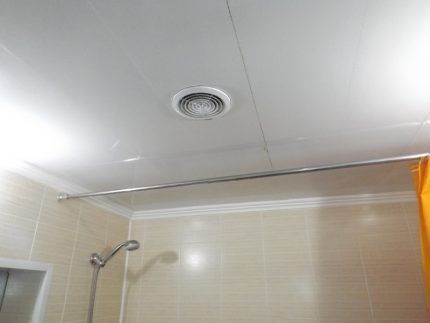
Organized ventilation in an apartment building consists of ventilation ducts located in the building structure, which are supplied to each apartment. The system is based on pressure differences between the head of the ventilation duct and the grille inside the room.
Since pressure drops cannot be called a constant phenomenon, this method of ventilation cannot provide sufficient air exchange in the rooms.
Also, natural air exchange may be ineffective for the following reasons:
- The tightness of plastic windows does not allow them to let fresh air into the room. So, room air goes into the exhaust duct, and instead of a fresh flow, air from the entrance enters the room, which is unlikely to be particularly fresh;
- Due to an incorrectly installed ventilation system, the entrance may freeze in winter, and along with this, the exhaust pipe will freeze. Since there is no exhaust, there are no areas of low pressure, which means it is impossible to ensure sufficient ventilation.
The problem may also be weather conditions. When the wind speed is high, the street air seems to be sucked back into the exhaust pipe.
So, it accumulates in the ventilation duct, and since the pressure only increases, dirty air can penetrate back into the room.

Unlike natural ventilation, which depends solely on weather conditions, forced ventilation is completely mechanized. A powerful fan ensures complete air exchange in the room, filling the rooms with fresh air around the clock.
Types of mechanical ventilation systems
Before constructing an artificial air exchange system, it is important to become familiar with the main types of ventilation and their application for specific rooms.
Depending on the purpose, the following types of ventilation systems are distinguished:
- Supply. Provides a forced flow of outside air into the room, while the incoming air masses can not only be heated or cooled, but also cleaned of micropollutants.
- Exhaust. Designed for quick and effective removal of contaminated air from the room. Such exhaust ventilation is often installed in the ceiling of the bathroom or kitchen, where there is the greatest concentration of odors and moisture.
- Supply and exhaust. Combined ventilation, providing simultaneous inflow and outflow of air artificially. Installations with a recuperator are considered the most effective, allowing the heat of exhaust air to be recovered and transferred to the incoming flow.
If the first two systems are installed only in specific rooms (kitchen, toilet), then supply and exhaust ventilation is intended to serve all rooms in an apartment or house.
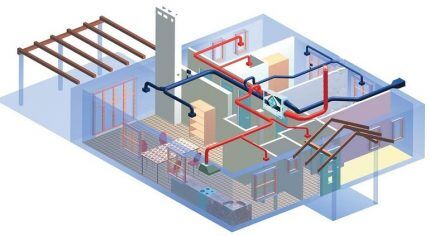
Each of the systems has its own installation and operation features, which should be carefully studied before drawing up a project for ventilating a room or building.
For example, there is no point in installing a supply and exhaust system in a small apartment with one room if you can choose a budget option - supply ventilation.
Supply ventilation device
In residential premises, an air supply system in the form of a monoblock is often installed. Compared to a prefabricated installation, the supply ventilation monoblock operates almost silently, and it’s quite easy to hide it in a suspended ceiling.
In this case, it is recommended to choose a device with fresh air heating. So, in the cold season, the room will be filled with street air, heated to the optimal temperature.
When installing a supply ventilation system, it is important to correctly determine the installation location. Ideal places for placement are the kitchen, corridor or balcony. You should not install a ventilation monoblock near the living room or bedroom, since noticeable noise may be observed during operation of the device.
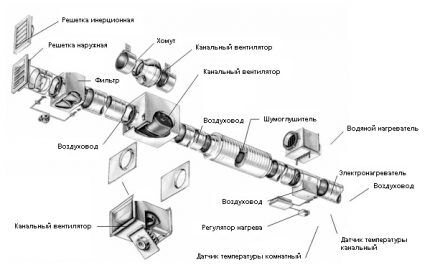
In a private home, you can install systems in the pantry, basement or attic. This will isolate the source of noise, which means saving on the purchase of a monoblock.
You can assemble and install the structure yourself, for which you will need to familiarize yourself with its structure:
- fan. It is he who “draws” fresh air into the room, significantly speeding up the ventilation process;
- filters. Installing filters allows you to protect the room from the ingress of wool, fluff, dust and exhaust gases;
- a heating element. Heats the air in the cold season, while in order to save money, for large rooms it is recommended to choose water heater;
- air ducts. Such pipes can be made of plastic, aluminum or stainless steel;
- automatic control system. Regulates the independent operation of the ventilation system, allowing you not to worry about switching modes.
In addition, the package may include a humidifier and air disinfectant. The main component of the supply system is the air valve, which is necessary to regulate the flow and block the entry of air when the ventilation mode is turned off.
Supply and exhaust systems – which one to choose?
This type of ventilation allows you to balance the air flows circulating between the room and the external environment. The supply and exhaust system removes polluted air from the room and at the same time provides an influx of fresh air.
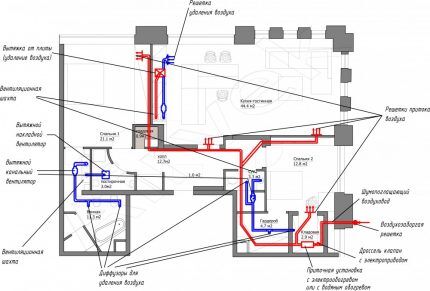
There are several supply and exhaust ventilation systems, each of which has its own unique configuration and functional features. When choosing such a system, it is important to take into account not only the dimensions of the rooms, but also the degree of their natural ventilation.
Option No. 1 - ventilation with recuperator
The presented system allows you to significantly save on electricity in winter. In this case, the exhaust air is not simply removed from the home, but also passes through the heat exchange unit, leaving its heat there for the cold street air. That is, the room is saturated with fresh air, heated by heat obtained from polluted room air.
This process is ensured recuperator. Depending on the application, it comes in two types: plate and rotary. The first is used in areas with a temperate climate, where there are no severe frosts in winter. It is recommended to equip ventilation units used in regions with colder winters with rotary heat exchangers.
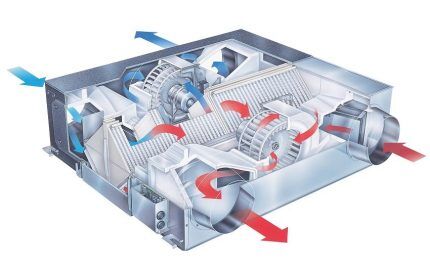
Since such a system can significantly reduce energy costs, it is often installed in large facilities: country cottages, offices, hotels and restaurants. This is an ideal option for a two-story house, thanks to which the owners will also be able to save not only on electricity, but also on heating.
Option No. 2 - air conditioning system
This system combines ventilation and air conditioning in one thermally insulated unit, providing a direct supply of heated or cooled air. Includes several power modes, which are set depending on the temperature change inside the living room.
Such forced ventilation systems are often installed in a suspended ceiling, which makes it possible to disguise the structure itself. Due to the low noise level, supply and exhaust system Can be placed in any room, even in a children's bedroom.
Such designs are a compact monoblock, so there is no need for external pipeline networks.
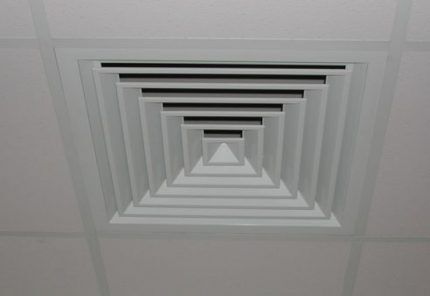
High power allows the device to purify the air and regulate the temperature inside large rooms, such as country cottages, offices and large halls. When installing such a system in your own home, you do not have to assemble the device from scratch and mess with air ducts.
Conclusions and useful video on the topic
You can learn how to independently arrange forced ventilation in a new apartment from this video:
When installing forced ventilation yourself in a private house or apartment, you must first decide on the type of system. Depending on the size of the room, the number of people living in the house, as well as the degree of functioning of natural ventilation, you can install a supply or supply and exhaust system.
Some systems can combine a cooler, heater and air purifier, which allows you to save on the purchase of additional devices.
If you have previously had to install forced ventilation on the ceiling yourself, then please share your experience in the comments below the article. Your experience will be very useful to many of our readers who are just faced with the problem of choosing a suitable ventilation system.



